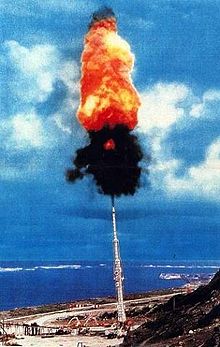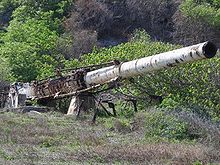- Project HARP
-
Not to be confused with HAARP, the High Frequency Active Auroral Research Program.
Project HARP, short for High Altitude Research Project, was a joint project of the United States Department of Defense and Canada's Department of National Defence created with the goal of studying ballistics of re-entry vehicles at low cost; whereas most such projects used expensive (and failure-prone) rockets, HARP used a non-rocket spacelaunch method based on a very large gun to fire the models to high altitudes and speeds.
Contents
Background
Started in 1961, HARP was created largely due to lobbying from Gerald Bull,[citation needed] a controversial but highly successful ballistics engineer who went on to head the project. Bull had developed the high-speed gun technique while working on anti-ballistic missile (ABM) and intercontinental ballistic missile (ICBM) research at CARDE in the 1950s, shooting models of high-speed interceptor missiles from guns as opposed to building supersonic wind tunnels, which would be much more expensive. The ABM project eventually ended without delivering a working system, but Bull was convinced the rocket systems he had developed had potential and started looking for other ways to use the technology.
HARP was such a development. The U.S. was in the process of testing newer ICBM systems and required repeated tests of newer re-entry vehicles. Bull suggested that the program could be run for considerably less money if the test vehicles were lofted from a large gun, as opposed to using rockets. This would also allow the test program's schedule to be greatly accelerated, as repeated firing was easy to arrange, compared to rockets. The key concept was the use of an oversized gun firing an undersized vehicle mounted in a sabot, allowing it to be fired with relatively high acceleration. Test electronics were potted in a mix of sand and epoxy, proving more than capable of withstanding the rigors of launch.
The project was based on a flight range of the Seawell Airport in Barbados, from which shells were fired eastward toward the Atlantic Ocean. Using an old U.S. Navy 16 inch (406 mm) 50 caliber gun (20 m), later extended to 100 caliber (40 m), the team was able to fire a 180 kilogram slug at 3,600 meters per second (13,000 km/h 8,000 mph), reaching an altitude of 180 kilometers (591,000 ft).[citation needed]
The program was canceled shortly after this. The politics of the Vietnam War (then in its fifth year) and soured Canada/U.S. relations played their role in the project's cancellation. The project received just over 10 million dollars during its lifetime.[citation needed]
During this time, many houses and buildings within a radius of 5-10+ miles developed cracks in their concrete reinforced walls, other damage such as cracked toilets, sinks, and household infrastructure were invariably damaged when the HARP gun was fired.[citation needed] In fact the vibrations could easily be felt miles away and may well have felt like a minor earthquake. After the project was canceled the gun remained for years and rusted parts may still be on the site abandoned. A couple of used barrels and what appeared to be an unused barrel were also left there.
Bull's ultimate goal was to fire a payload into space from a gun, and many have suggested that the ballistics study was offered simply to gain funding. While the speed was not nearly enough to reach orbit (less than half of the 9 km/s delta-v required to reach Low Earth Orbit), it was a major achievement at much lower cost than most ballistic missile programs.
Project Babylon
Bull never gave up on the idea of building a gun-fired satellite, but was forced to turn to other work. Through the 1970s and 80s he developed a new artillery piece that dramatically outperformed all others. His design, the GC 45, attracted wide attention. Looking for customers, Bull sold the gun to South Africa (then under the Apartheid system) and then to Iraq. He was arrested and jailed in the U.S. for the sales to South Africa, and left Canada after his release to reside in Brussels.
He then resumed work with Iraq, convincing them to build a new satellite launcher gun, Project Babylon. Saddam Hussein agreed to fund the project, but only if Bull helped with their efforts to re-design the re-entry vehicle of the SCUD missiles in order to improve range. Bull agreed, making him an enemy of Iran and Israel, the intended target of the longer-range missiles. The March 1990 assassination of Bull (allegedly at the hands of the Israeli Mossad or the Iranian VEVAK intelligence agency) in his Brussels apartment, and the 1991 Gulf War ended the project mid-term.
Martlet projectiles
There were several models of test projectile fired or designed during Project HARP.
- Martlet 1
- The first test projectile. 16-inch (410 mm) gun bore, projectile weighed 450 lb (200 kg), was 6.6 inches (170 mm) in diameter and 70 inches (1,800 mm) long. Only four manufactured. Two were fired on Jan 21 and Feb 1, 1962.
- Martlet 2
- Primary 16-inch (410 mm) test projectiles. Around 200 fired, of various weights and configurations. Most carried research payloads studying upper atmosphere and near space conditions. About half the weight of the typical Martlet 2 series projectile was in the pusher plate and centering sabot.
- Martlet 2G
- A more advanced projectile, which had nearly all of its total 350 lb (160 kg) weight in the projectile. The Martlet 2G utilized a sabot system very similar to modern antitank kinetic energy penetrators.
- Martlet 2G-1
- A proposed space launch vehicle variant of Martlet 2G, which had a solid rocket motor in the projectile. The follow-on 2G-2 would have had a second rocket motor and been able to place the second stage in orbit, though with little or no payload.
- Martlet 3
- A series of more advanced rocket propelled projectiles in the HARP project.
- Martlet 3A
- Intended to be a 16-inch (410 mm) diameter, gun fired rocket projectile able to reach 500 km altitude. The rocket motors' solid propellant deformed during firing and the design was never successful, despite several test firings.
- Martlet 3B
- Similar to the Martlet 3A, using steel casings and attempting to solve some of the 3A model's problems. Unsuccessful.
- Martlet 3D
- This model was going to be a suborbital test rocket, using the first stage of the Martlet 4 solid rocket version. As Martlet 4 was never built, no Martlet 3Ds were produced either.
- Martlet 3E
- A suborbital solid rocket designed to be fired from a smaller, 7-inch (180 mm) cannon used in the HARP project.
- Martlet 4
- Two versions of full scale orbital launch vehicle projectiles were proposed in the Martlet 4 series. The first used three solid rocket motor stages and was planned to orbit about 50 pounds of payload. The second used liquid rocket motors and was planned to have orbited 200 pounds of payload. Both were about 28 feet (8.5 m) long and 16 inches (410 mm) in diameter, weighing about 2,900 pounds (1,300 kg) at launch. No Martlet 4 vehicles were built; the project halted before the design was completed.
See also
Super High Altitude Research Project
Further reading
- Gerald V. Bull, Charles H. Murphy, Paris Kanonen: The Paris Guns (Wilhelmgeschutze) and Project HARP, E. S. Mittler, Herford, 1988.
- Carter, Gercine (23 April 2010). "HARP-ing on a memory". Nation Newspaper. http://www.nationnews.com/news/local/Carlton-Brathwaite-FEATURE-copy-for-web. Retrieved 23 April 2010.
- Fraser, Henry S. (21 August 2011). "Things That Matter: The Great Guns of Barbados". The Barbados Advocate. Archived from the original on April 25, 2010. http://web.archive.org/web/20100425031747/http://www.nationnews.com/news/local/Carlton-Brathwaite-FEATURE-copy-for-web. Retrieved 21 August 2011.
- "Local knowledge of HARP". Caribusiness Admin. Angela Cole. December 2nd, 2008 @ 10:13 AM. http://angelacole.caribusiness.com/Home/about--angela-cole/the-paris-airshow/overpaid-bajans/extracts/gerald-bull/localknowledgeofharp. Retrieved October 18, 2011.
External links
- Astronautix's very detailed account of the HARP Project
- Detailed information about the Martlet projectile models at Astronautix.com
- World's Largest Gun — Popular Mechanics article by Paul Eisenstein
Categories:- 1961 establishments
- Barbados–Canada relations
- History of Barbados
- McGill University
- Superweapons
- Space weapons
- Spaceguns
- Military projects
- Abandoned military projects of the United States
- Abandoned military projects of Canada
- Non-rocket spacelaunch
Wikimedia Foundation. 2010.


